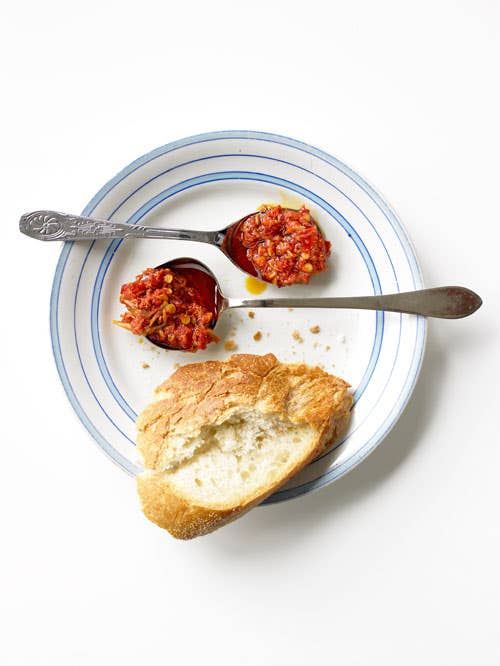
I have known many condiments in my lifetime, and I have known many fish. But until I enrolled in a pizza-making class in Manhattan last year, I had never known how perfect a union of the two could be. As we embellished our pies with the usual mozzarella and basil, the school's owner dug into his refrigerator and produced a jar containing a thick, slightly oily red relish. He handed me a spoon, and a few moments later my obsession with neonata began. It was fiery, succulent, and totally invigorating, with a red-pepper sweetness underscored by an anchovy funk. I slathered some on a slice and took a bite. Needless to say, it yielded a pizza like no other.
The condiment is made from infant fish called neonata ("new born" in Italian) that are caught off the coast of the southern region of Calabria, where the spread originated. These small fry—anchovies, sardines—have a jelly-like consistency thanks to their soft young bones. They're preserved with salt, a mix of sweet and hot peppers, and occasionally olive oil, and left to cure for a month. The result could be called an Italian nuoc mam, though Italians refer to it as il caviale del sud, the caviar of the south.
This fish sauce, which goes by the name rosamarina in Calabria, may well have remained unknown to me if not for D. Coluccio & Sons, a Brooklyn importer that began carrying it more than a decade ago. But thanks to the ease and low cost of preparation, neonata has long been a Calabrian staple. It lasts for about a year, a longevity that has made the protein-rich product especially valuable during times of famine and war when food is scarce.
On its home turf, neonata is used to anoint pasta, or smeared on toast with red onion and tomato, where it adds an umami punch that heightens other flavors without overwhelming them. I also like to toss it with sauteed squid and broccoli rabe for depth and kick. And I rarely eat pizza without it.
Neonata, $8.50 for a 6.7-ounce jar at dcoluccioandsons.com
Keep Reading
Continue to Next Story










